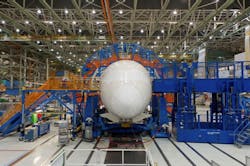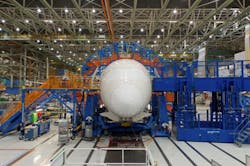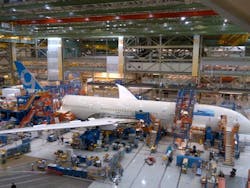Aerospace materials market to grow globally through 2019
DALLAS, 11 March 2015. The global aerospace materials market is projected to grow at a compound annual growth rate of 6.6 percent through 2019, when its value will reach $18.5 billion, according to market analysts at RnRMarketResearch.com.
The commercial aircrafts application segment holds a roughly 70 percent market share by volume, constituting a significant part of the overall aerospace composite market. The general aviation segment, including business jets (or bizjets), is predicted to grow at the fastest rate (compared to commercial and military aviation segments) by 2019. The high growth can be attributed to the rise in business jets from the Asia-Pacific, the Middle East, and Latin America.
Among different aerospace material types, aluminum alloys occupied the highest market share in terms of volume in 2013, whereas titanium alloys occupied highest market share in terms of value.
The composite materials segment is the fastest-growing type due to growing consumption in commercial, business, and military aircraft given several advantages, such as light weight, corrosion resistance, high heat resistance, and a higher strength-to-weight ratio.
The rise in demand for fuel-efficient aircraft and increasing air traffic in emerging economies due to robust economic growth are the two main drivers of the market.
Decreasing defense spending is expected to result in a decrease in the production of military aircraft is expected inhibit the growth to some extent.
The major players in the Aerospace Materials Market are Cytec Industries, E. I. Du Pont De Nemours, Kobe Steel Limited, Alcoa, Toray Industries, Teijin Limited, Aleris International, AMG N.V, ATI Metals, and Constellium N.V.
Region-wise, North America and Europe are leading the global market. Growth in Asia-Pacific is the highest owing rising demand for fuel-efficient aircrafts and increasing demand for the business jets in the region. The growth is also aided by growing aircraft manufacturing industry in the region and expansion activities by some major aircraft manufacturers and OEMs in the region due cheaper raw material and labor prices. Due to the region's favorable prospects, several companies are expanding in Asian countries to benefit from the low-cost structures and growing local demand from the region aircraft building industry. Commercial aircrafts represent the largest application of aerospace composites. This could be owed to the two major OEM's, Airbus and Boeing, who is leading commercial aircrafts market with around 60.0% of the total market.
Aerospace materials are those materials used by the aircraft manufacturers and OEMs for building various aircraft parts; among those various materials are aluminum alloys, steel alloys, titanium alloys, super alloys, and composite materials.
Composite materials in aerospace are used primarily because they have a higher strength to weight ratio than metals; they help save a fuel, decreasing harmful fuel emissions into the atmosphere. The various types of aerospace composites that have been included in this report are: glass fiber reinforced plastics, carbon fiber reinforced plastics, metal matrix composites (MMC), aramid fiber composites, and ceramic matrix composites (CMC).
The aerospace materials industry is moving towards investment in the implementation of technologies to produce new and high-quality products. The companies involved in this market are extensively into research and new product developments.
The report analyzes the global aerospace composite market trends and forecasts till 2019. The market size has been provided in terms of market volume (KT) and value ($million). The report also identifies prominent players and provides analysis for each player in terms of company overview, financials, products & services offered recent developments, and company strategy. Order a copy of the complete report on Aerospace Materials Market by Type (Aluminum Alloys, Steel Alloys, Titanium Alloys, Super Alloys, Composites), by Aircraft Type (Commercial Aircraft, Business & General Aviation, Civil Helicopters, Military Aircrafts) - Global Trends and Forecast to 2019 available at http://www.rnrmarketresearch.com/aerospace-materials-market-by-type-aluminum-alloys-steel-alloys-titanium-alloys-super-alloys-composites-by-aircraft-type-commercial-aircraft-business-general-aviation-civil-helicopters-mi-market-report.html and http://www.rnrmarketresearch.com/contacts/purchase?rname=309532.


